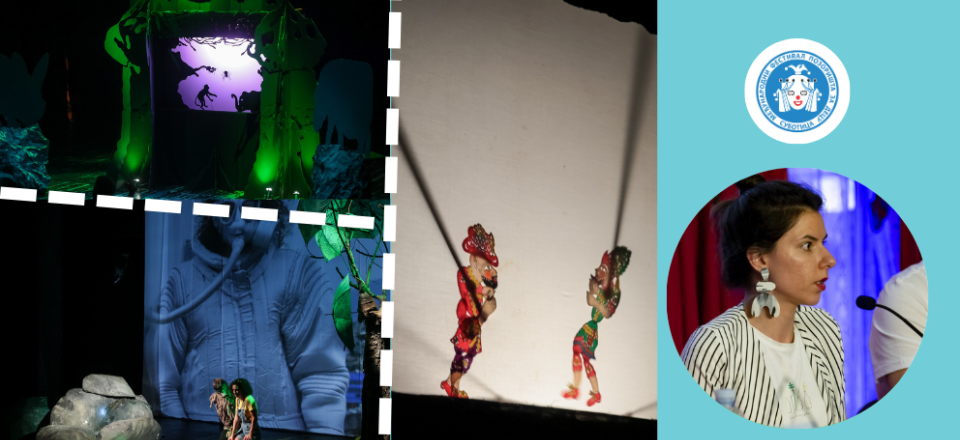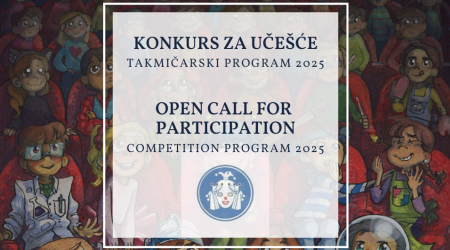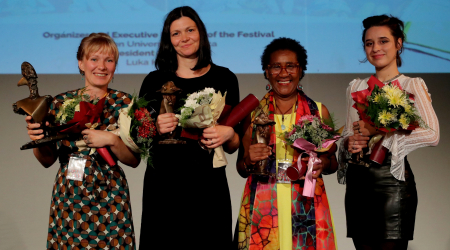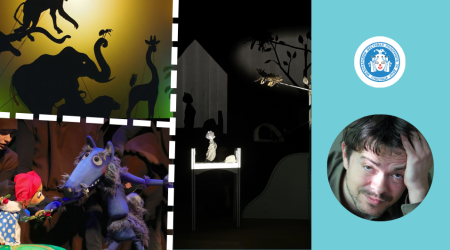News
The Nature and the Shadow
Back to...
The following review is analyzing three plays performed on the fourth day of the festival: The Green Mountain, The Magic Tree and Simona the Monkey. Beside the fact that they were all performed on the same day, what connects them further are their subjects (environment and nature) and utilization of elements belonging to the shadow play.
Ecology and environmental protection is a necessary - albeit a rather ungrateful topic - in theatre for children and young people. On one hand, raising awareness about environmental pollution and personal strategies in which an individual can contribute to the reduction of waste and preservation of nature is important, but on the other hand, the guilt and responsibility for this is the least on the individual/average audience member. The destruction of nature done in the name of capital is immeasurable and the consequences of capitalist ideology are incalculable. In short, us giving up plastic straws and plastic bags won’t be nearly enough an effort if corporations proceed with mining and releasing massive pollution into the water, land and air. As for the shadow play, its traditional form has long been associated with the moment of passing, the dead, sleep, the great beyond. A Chinese legend attributes the origin of shadow play to Emperor Wu (140-86 BC) who wanted to speak with his deceased wife. Although this anecdotal curiosity cannot be treated as a historical fact, it does reveal a pattern: the shadow play’s artistic concept is set to erase the boundaries between the real, rational, specific, tangible and that "on the other side" - irrational, supernatural and metaphysical. The contemporary shadow play does not adhere firmly to this symbols, but in certain scenes of the Festival’s plays the outlines (or shadows, pun intended) of this logic were recognizable.
NGO Youth Theatre, Montenegro
Author: Mila Mašović Nikolić
Director: Branko Ilić
Cast: Danica Rajković, Lazar Đurđević, Katarina Krek/Maja Šarenac Stage
Design: Vana Prelević
Puppet Design: Ana Krgović
Music: Ivan Marović
The Green Mountain follows the story of Gorana – a girl trying to preserve a part of the forest while her mother wishes to sell the land to a rich investor in order to solve the family's financial troubles. The didactic nature of the play often leads to patronizing, because it is based on fear-mongering (through a video clip, it is suggested to the audience that the lives of their descendants will be apocalyptic and dystopian, as there will be no food and air). The acting is fast-paced, the conflict between Gorana and the arrogant rich man is clearly laid-out and the mother’s change of heart (into ultimately deciding to spare a part of the forest) leads to lessons on the necessity of fighting for the land and discussion on these topics. The video’s purpose was to personify Mother-nature and to play out another spatial plan thru shadows. In the play, the shadows always represent silhouettes of strangers, someone unknown and terrifying - first a wolf and later the investor. A fire and a destroyed (and then restored forest) are projected onto the canvas. This is also the best directed scene of the play.
Audience impressions after the play:
"It was great when they played the gusle." (a boy, age 9 year)
"In the end, did the brother and Milica kiss at the beach? In the beginning, he says that he is going to the beach to kiss her." (a boy, age 9)
"I was scared when there was a fire in the forest." (a girl, age 6)
"Personally, the best line was when the mother said to her daughter: Hold on, Gorana, can’t you see that the investor is donating us own own land." (male audience member, age 30)
Shadow Theatre “Cengiz Ozek”, Turkey
Writer, Director, Stage/Puppet Design: Cengiz Ozek
Cast: Cengiz Ozek, Ege Uyanik
Music: Ege Uyanik
The drama The Magic Tree is based on the traditional Turkish puppet hero Karagoz and his best friend Hacivat. Trouble arises when Hacivat sends his servant Mercan to Karagoz for education. The process does not go according to plan, so Mercan casts a curse on Karagoz in front of whose house an enchanted evil tree appears. Karagoz does not care about nature, so he plucks the leaves from the tree and kills the worm living inside it. In return, he is punished and transformed into a donkey. When the teacher learns his lesson about protecting the environment, he becomes human again. The play being performed entirely in Turkish without a translation available, it’s possible that the plot deviates slightly from what the author/actor performed on stage. As the actor, Cengiz Ozek showcased an incredible skill in operating several puppets simultaneously and an enormous talent and coordination considering that he also spoke the lines of every character. The situations between the characters were, of course, repeated multiple times which might not have been seen as a pacing issue if we had an understanding of the language and context. In this case - when the narrative was understood only by interpreting the physical action - it eventually became tiresome. The teacher Karagoz and his pupil were accompanied by the sound of the tambourine - an instrument associated with the folk character puppet since the 18th and 19th century.
Audience impressions after the play:
"I like the Turkish language." (a boy, age 8)
"It was funny when a fly was, like, buzzing around the vase in the beginning." (a girl, age 7)
"It was a little long, but I liked it." (a boy, age 8)
La Sonrisa del Lagarto Theatre, Spain
Writer, Director: Marli Santana
Cast: Marli Santana, Ave Hernandez
Stage/Puppet Design: La Sonrisa del Lagarto
As was the case with the previous play, the language barrier was insurmountable. Simona the monkey waits for the morning to witness the sunrise. To keep her awake until dawn, the other animals entertain her by telling tales. Spatially, events and characters of the forest are separated from the tales. The elephant tells a story about a snake, the Lion about the wind that blew so hard it blew away the girl's scarf. Utilizing shadows allows for clear transition between the real world of the forest and the fictional world of the stories keeping the animals awake. The way the actress (mesmerizing Marli Santana) lends her voice to the main character of Simona - without hiding behind the screen - is truly exciting. The animation of the puppets seemed random, especially in comparison to The Magic Tree. The movement of animals was arbitrary and plans were interfered with. After the show, the actresses showed everyone in attendance how to create a home version of the shadow play in only four steps. Every visitor was offered a free cut-out monkey to take home so they could recreate the shadow play themselves. Such an approach not only empowers the audience, but also demystifies the process of creating theater art. The show was over, but the magic of theatre goes on!
Audience impressions after the play:
"That’s All, Folks!" (a boy, age 6)
"I didn’t understand a thing" (a girl, age 6)
"I don’t speak Spanish and she spoke Spanish a lot." (a girl, age 6)
“In the end, the sun looked just like an egg sunny side-up.” (a boy, age 7)
Divna Stojanov
Back to...-
 29 october 2024
29 october 2024Call for Proposals of Participants for 16th Theater Art Research Forum for Children and Youth
-
 25 october 2024
25 october 2024Open call for participation in the competition programme of the 32nd Festival
-
 28 september 2024
28 september 2024Don’t Wait for Me… announced the best play of the 31st International Festival of Children's Theatres Subotica
-
 02 october 2024
02 october 2024IS THERE ANYTHING MORE BEAUTIFUL THAN THE THEATRE?









